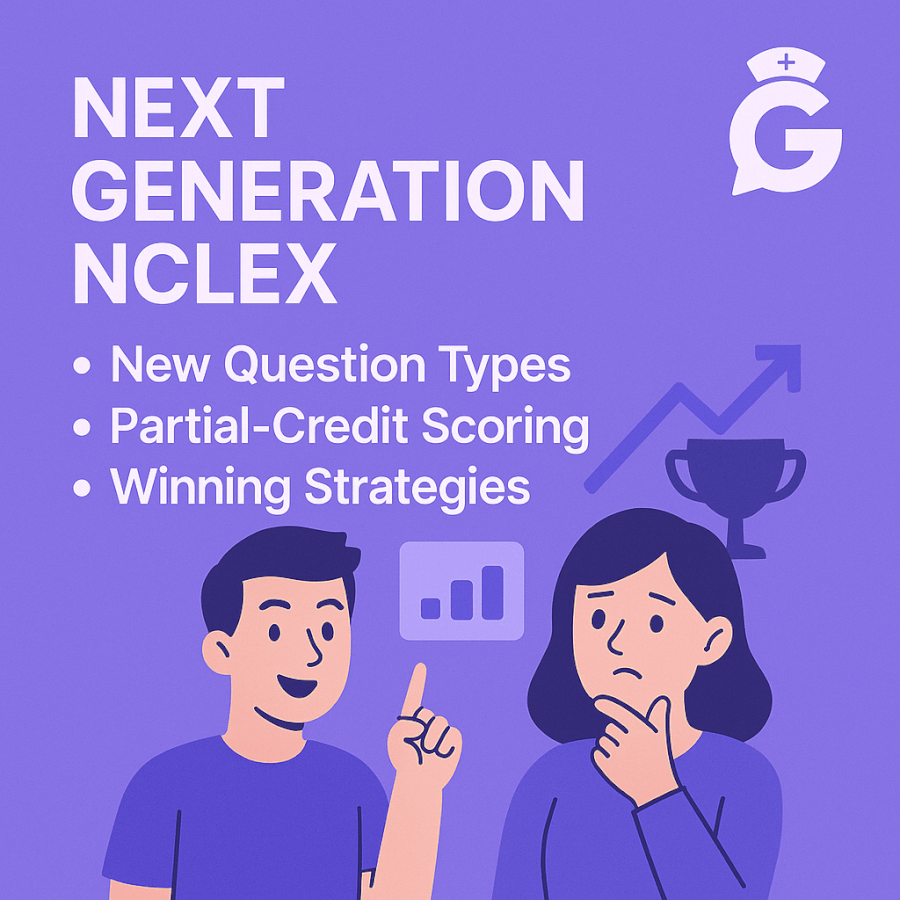I. Introduction: Welcome to the Next Generation NCLEX
The Next Generation NCLEX (NGN) launched in April 2023, transforming the licensure exam into a more dynamic assessment of clinical judgment. Instead of focusing solely on recall and simple application, the NGN measures your ability to collect cues, analyze data, prioritize hypotheses, and make safe decisions in real‑world scenarios. This shift means more interactive question types and a new partial‑credit scoring system. Whether you’re a nursing student preparing for your first attempt or a repeat test‑taker getting familiar with the changes, understanding the NGN is vital for success.
🎯 Free NGN quiz!
See how well you know the new item types and scoring rules.
In this comprehensive guide, you’ll learn about each new item type, explore the three partial‑credit scoring rules, and discover study strategies to build clinical judgment skills. We’ll also link to other GoodNurse resources for deeper dives into pharmacology, study techniques, and anxiety management so you can create a complete NGN prep plan.
II. What’s New: A Breakdown of NGN Item Types
Traditional NCLEX questions relied heavily on multiple‑choice, select‑all‑that‑apply and basic drag‑and‑drop formats. The NGN introduces case studies and standalone items designed to simulate actual patient scenarios. These items test how you gather and analyze information, prioritize patient needs and evaluate outcomes. Below are the new item types and how they work.
A. Highlighting
Highlighting questions present a scenario or a piece of text, and you must highlight the most relevant pieces of information. For instance, a case study might describe a patient’s symptoms and ask you to highlight cues that indicate impending shock. Practicing active reading is crucial; pay attention to vital signs, time frames and keywords indicating changes in status.
B. Cloze (Pull‑Down Menu)
These questions display a sentence or paragraph with blank spots. You select the correct answer from drop‑down menus to complete the statement. Cloze items often test your ability to prioritize interventions or list steps in a process. They reward careful reading—ensure each selection fits logically with the surrounding text.
C. Matrix/Grid
Matrix or grid questions are essentially tables where you match statements or concepts across rows and columns. A matrix question might list symptoms down the left side and disorders across the top; you then select which symptoms correspond to which disorder. Some matrix questions allow multiple selections per row (select all that apply), while others ask you to select one per row. Matrix items may also require drag‑and‑drop interactions.
D. Extended Multiple Response
Unlike traditional select‑all‑that‑apply (SATA) items, extended multiple‑response questions may contain more than one correct answer and often require selecting a specified number of responses. The directions could say “Select three actions the nurse should take,” which prevents guessing by forcing you to choose exactly three options.
🥇Voted #1 Nursing Study Tool.
Personalized AI Tutor + Instant Answers to All Your Questions. 100% Money Back Guarantee!
E. Trend Item
Trend items display a series of images, vital signs, or lab results over time, asking you to identify patterns or evaluate changes. For example, you might be given successive heart rhythm strips or wound photos and then asked to determine if the patient’s condition is improving, stable or worsening. Trend items test your ability to interpret evolving data and adjust care plans accordingly.
F. Extended Drag and Drop, Including Bowtie
Traditional drag‑and‑drop items had you place items in a sequence (e.g., steps to don PPE). Extended drag‑and‑drop items go further by combining multiple elements or requiring you to drag answer choices into multiple fields. The “Bowtie” format presents two columns with answer targets on either side and a central column to categorize diagnoses, interventions or rationales. This type tests your ability to synthesize information and link related concepts efficiently.
III. Beyond Right or Wrong: Understanding Partial‑Credit Scoring
The NGN uses polytomous scoring, meaning you can earn partial credit based on how many correct responses you select and whether you avoid incorrect options. Here’s a breakdown of the three scoring methods.
A. Plus/Minus ( +/− ) Scoring
In plus/minus scoring, you gain points for correct answers and lose points for incorrect ones. For example, if a question asks you to select all North American countries from a list and you select Mexico, Canada and the United States correctly but also choose France (incorrect), you might earn three points for the correct answers and lose one point for the wrong answer, resulting in two points total. This method penalizes guessing, so be sure about each selection.
B. Zero/One (0/1) Scoring
Zero/one scoring awards points only for correct selections without deducting for wrong choices. Using the same example, you’d earn a point for each correct North American country you select and receive no penalties for incorrect choices. This method rewards knowledge but does not penalize guessing, though you still risk diluting your score if you don’t select enough correct answers.
C. Rationale (All‑Or‑Nothing) Scoring
In rationale scoring, responses are grouped into linked pairs or sets. You must select all linked components correctly to earn any points. For instance, you might drag city names into a paragraph describing world capitals; if you incorrectly match one capital to its country, you earn zero points for that pair. This method tests your ability to understand relationships between concepts rather than selecting stand‑alone answers.
D. Benefits of Partial‑Credit Scoring
Partial‑credit scoring provides more precise measurement of clinical judgment. It acknowledges that you may know some, but not all, correct answers and minimizes the impact of random guessing. As you prepare for the NGN, focus on accuracy and avoid selecting extra answers unless you’re confident; partial credit works to your advantage when you know exactly what is correct.
IV. Tips for Tackling NGN Item Types
A. Approach Case Studies Like Real Patients
Each case study features a multi‑item scenario spanning the six steps of the clinical judgment measurement model (Recognize Cues, Analyze Cues, Prioritize Hypotheses, Generate Solutions, Take Action and Evaluate Outcomes). To prepare:
- Practice reading case vignettes fully before answering. Identify vital information such as allergies, lab values and patient history.
- Use process‑of‑care models to structure your thinking. Write down cues, hypotheses and possible interventions to avoid missing critical details.
- Reflect on previous clinical experiences to strengthen your critical thinking; case studies reward your ability to connect textbook knowledge with real‑world scenarios.
B. Master Each Item Type Individually
Familiarize yourself with the mechanics of each NGN question type by practicing:
- Highlighting: Use note‑taking and annotation tools when reading textbook chapters; this trains your brain to pinpoint key information quickly.
- Cloze: Take short paragraph questions from NCLEX resources and cover up words. Challenge yourself to complete them with minimal hints.
- Matrix/Grid: Create matrix charts when studying pathophysiology. This helps you memorize relationships like signs and symptoms across different diseases.
- Extended Multiple Response: Practice choosing exactly the number of responses asked for; do not over‑ or under‑select, as it may affect your score.
- Trend Items: Study lab values and vital sign trends. Look for patterns in fluid and electrolyte imbalances or shock progression.
- Bowtie/Extended Drag and Drop: Draw concept maps linking diseases to symptoms, interventions and rationales. Then practice categorizing them quickly.
C. Prioritize Clinical Judgment Skills Over Memorization
The NGN exam still evaluates core knowledge, but it places equal emphasis on decision‑making. Develop clinical judgment by:
- Studying integrated topics. For example, when learning cardiac pharmacology, also review symptom recognition and nursing interventions.
- Practicing problem‑solving. Work through case studies in your textbooks and online resources, stopping to ask yourself why each intervention is necessary.
- Seeking feedback. Discuss practice questions with peers or instructors to identify any gaps in your reasoning process.
V. Building an Effective NGN Study Plan
A. Start with a Diagnostic Assessment
Before setting your schedule, assess your baseline knowledge. Take a practice NGN exam or a high‑quality test with Next Gen items. Note which clinical judgment steps and categories challenge you the most. This will guide your study priorities.
B. Leverage GoodNurse Resources
- Focus on content foundations: Read NCLEX Pharmacology Made Simple and NCLEX Cardiovascular Drugs In‑Depth to master high‑yield medications and their nursing considerations.
- Study test structure: NCLEX Categories Explained (2025) clarifies how exam categories align with clinical judgment tasks.
- Learn from our NGN guide: Check How to Pass the Next Gen NCLEX (NGN) for more strategies and a sample study schedule.
- Address anxiety: Conquering NCLEX Anxiety helps you develop relaxation techniques and a positive mindset.
C. Schedule Regular NGN‑Style Practice
Aim to complete multiple NGN case studies per week. GoodNurse’s adaptive quiz bank includes case study sets that mirror the NGN format. Use rationales to understand why certain cues or hypotheses lead to specific interventions. Over time, gradually reduce the time you allow yourself per case to improve efficiency.
D. Review Partial‑Credit Strategies
Because some NGN questions penalize incorrect selections, practise answering with precision. When you’re unsure, narrow options using elimination strategies and lean on evidence‑based reasoning:
- For +/− scoring items, only select answers you’re confident are correct; an extra wrong choice can reduce your score.
- For 0/1 scoring items, select all that apply even if you aren’t sure; wrong answers won’t harm your score.
- For rationale scoring items, identify and pair concepts correctly; if an item asks for a medication and its mechanism, ensure the pair matches.
E. Balance Study With Well‑Being
As you prepare, maintain healthy habits: exercise regularly, get sufficient sleep and stay connected to friends and family. Managing stress improves concentration and retention. Consider scheduling study sessions during your most alert times of day and taking breaks to avoid burnout.
🚀 Test your NGN readiness!
Try our comprehensive quiz bank to reinforce your knowledge.
VI. Final Thoughts and Additional GoodNurse Resources
The Next Generation NCLEX challenges you to demonstrate clinical judgment, not just recall. While the new item types and partial‑credit scoring may seem daunting, they ultimately reward deep understanding and thoughtful decision‑making. By familiarizing yourself with each question format, practising case studies and mastering the scoring rules, you’ll turn these changes into an advantage.
To continue strengthening your preparation, explore:
- NCLEX Study Tips That Actually Work in 2025: Proven strategies, tools and hacks to build a personalized plan.
- Failed the NCLEX? Here’s Your Step‑by‑Step Comeback Plan: A structured roadmap for retesting with confidence.
- NCLEX Anxiety Management: Stay calm and focused with meditation, breathing and self‑care techniques.
Armed with the knowledge of new NGN item types, a clear understanding of partial‑credit scoring and a strategic study plan, you’re ready to tackle the Next Generation NCLEX and launch your nursing career.






